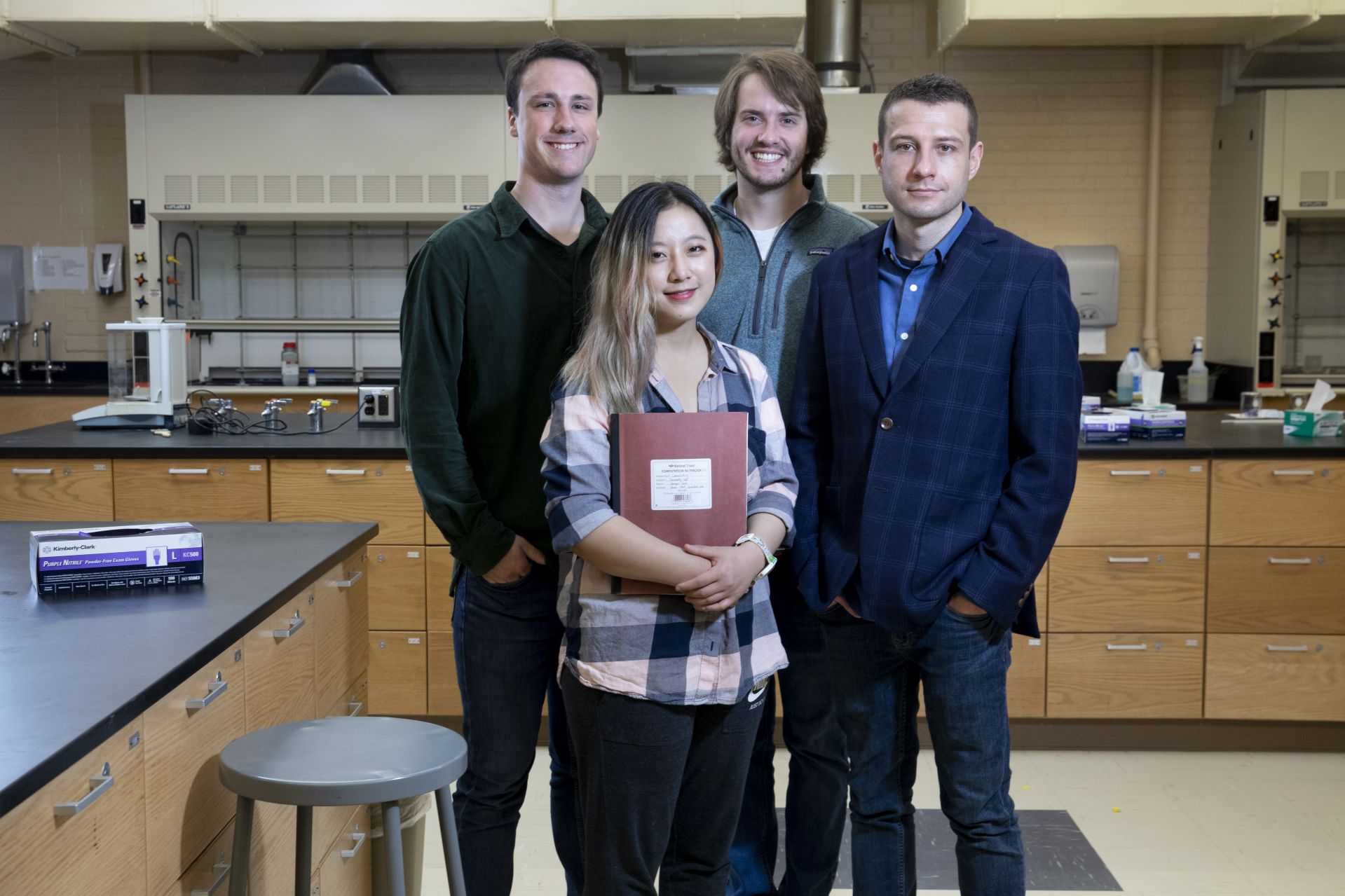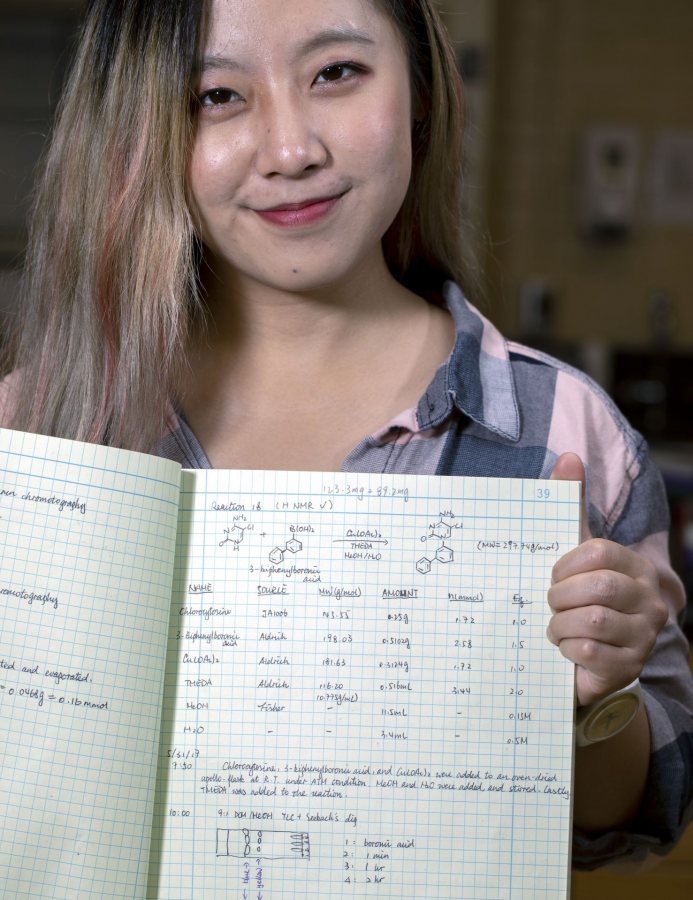
Invented by Bates students in their professor’s lab, a molecule with a Bates-inspired nickname carries enough pharmaceutical promise that Bates has filed a provisional patent application for the molecule.
Synthesized in 2017 in the lab of Assistant Professor of Chemistry and Biochemistry Andrew Kennedy, the molecule Bobcat339 has the potential to govern the function of genes related to memory loss and genes that aid and abet the spread of cancer.
A provisional patent application protects the college’s intellectual property for a year until a formal patent application is completed.
All told, seven Bates students broadly contributed to research leading to the creation of Bobcat339; for their contributions, the seven are co-authors of the recently published scholarly article, “Cytosine-Based TET Enzyme Inhibitors,” which outlines the synthesis and promise of Bobcat339.

With their professor, Andrew Kennedy (right), three of the seven student coauthors of the scholarly article describing Bobcat339 posed last May in Dana Chemistry lab: from left, Michael Bennett ’19, Haoyu Sun ’19, and Nathanael Kuzio ’19. (Phyllis Graber Jensen/Bates College)
The student coauthors are Emma Jarczyk ’17, Joseph Alp ’18, Gabriella Chua ’18, Kelly Wassarman ’18, Haoyu Sun ’19, Nathanael Kuzio ’19, and Michael Bennett ’19. Kennedy is a coauthor, too, as is Assistant Professor of Biology and Neuroscience Martin Kruse, who contributed a cell culture experiment.
The Kennedy lab works in epigenetics, a field that looks at how genes can change their function without being altered themselves. Kennedy’s ongoing work includes important achievements in potential therapies for the autism-spectrum disorder called Pitt Hopkins Syndrome.
About that Bobcat name
Giving a novel compound like Bobcat339 a simple nickname is useful, says Kennedy. And that’s a vast understatement, since the molecule’s full name is: 1-([1,1′-Biphenyl]-3-yl)-4-amino-5-chloropyrimidin-2(1H)-one.
While “Bobcat” places the creation at Bates, the numerals “339” also tell a story. The first “3” identifies Haoyu Sun, the third of four students (thus far) who have synthesized molecules for testing in the Kennedy lab. (Nos. 1, 2, and 4 are Jarzyk, Wassarman, and Kuzio.)
The last two numbers, 39, indicate the specific page of Sun’s well-worn lab notebook, where you can find the description of Bobcat339’s creation — its recipe, if you will — which took place on May 31, 2017. (Each page of each student’s notebook, front and back, describes the synthesis of one molecule that the lab will test, totaling upward of 50 molecules.)

Last May, Haoyu Sun ’19, researcher No. 3 for Bobcat339, displays the pivotal page 39 of her notebook describing the synthesis of Bobcat339. (Phyllis Graber Jensen/Bates College)
The field of epigenetics tries to answer a question that confounded early cell biologists. If nearly every cell in our body contains our entire genome, how is it that some cells become the liver, and others become brain cells?
“How does this happen?” Kennedy asks, rhetorically. “It’s as if you handed the exact same blueprint to three different contractors, and they create three different homes.” At one level, “it just doesn’t make sense,” he says.
The answer, he explains, resembles how two libraries might arrange the same collection of books. The Neuron Library would place neuron-specific books up front for frequent use, and put books about liver cells into storage so they’re inaccessible until needed.
The Liver Library, however, would do it the other way around, putting the liver books up front for frequent access and storing the neuron books.
To extend the library metaphor, there’s a very powerful “librarian” at work: Known as DNA methylation, it’s a process that decides where and how genes are either read or put into storage, and thus what kind of cell the genome produces.
Presto! Assistant Professor of Chemistry Andrew Kennedy draws the chemical structure of 1-([1,1′-Biphenyl]-3-yl)-4-amino-5-chloropyrimidin-2(1H)-one, aka Bobcat339:
Methylation refers to the placement of methyl groups, composed of parts of molecules made of a single carbon atom bonded to three hydrogen atoms, directly onto DNA. This placement “alters whether or not genes near that methyl mark are expressed or silenced,” Kennedy explains.
Enter Bobcat339, a molecule that throws a “wrench in the gears” by preventing a certain enzyme, known as TET1, from doing its usual job of removing a methyl from a gene.
This ability gives Bobcat339 promise in the world of drug discovery. “There’s great interest in creating TET inhibitors as an avenue to potentially dial back the aggressiveness of some cancers,” Kennedy explains
The lead author (and it’s not the professor)
For a lab like Kennedy’s, creating a novel compound is pretty straightforward, as it is for a chef creating a new soup.
A chemist can “quickly make a molecule that’s never existed on this planet — probably never existed in the universe,” Kennedy says. “The possibilities are infinite for molecular structure.”
Creating a new soup or molecule is easy; it’s far harder to create a dish that dazzles the palate — or a specific molecule to accomplish a specific epigenetic task, says Kennedy. “My students and I will go to the chalkboard and design dozens of ways to make a molecule. And we try to rationalize, based on what we know, the most likely route to success.”
It involves a lot of trial and error. Kennedy compares it to how a climber might imagine a new route to a peak. “You can see the peak. And you might imagine that the north face is the easiest way up. But then you start the climb and find an obstacle you couldn’t see from the ground. So you have to backtrack and try again.”
Enter one of Kennedy’s trailblazers: Gabriella Chua. She’s the lead author of the paper describing Bobcat339, not Kennedy. “It’s often the case in science,” explains Kennedy, “that the lead author knows more about the genesis and trajectory of the project, and this is very true in Gabby’s situation.”

Gabriella Chua ’18, the lead author of the paper describing the creation of Bobcat339, served as the eyes and ears for Kennedy’s lab during her senior year. (Theophil Syslo/Bates College)
During her senior year, Chua served as the Kennedy lab’s eyes and ears as the team churned out and evaluated dozens of new molecules, including Bobcat339.
Chua was well-prepared for that leadership role thanks to earlier courses with Kennedy and other Bates professors, including her junior-year advanced organic chemistry course, where Kennedy “pushed us to do our own, more independent problem solving and thinking,” she said.
“Grappling more with uncertainty than with certainty.”
Instead of just seeking answers to questions, as she had so far in her coursework, she was now being asked to frame original research questions.
That meant “grappling more with uncertainty than with certainty,” she says. “I became curious with the process of science, and how we’ve been able to make definitive conclusions about the things we consider ourselves to understand.”
Senior-year research in Kennedy’s lab was a “way to follow these curiosities in a productive way,” she says. Importantly, “he gave me the space and trust to do these things.”
Chua’s job was to evaluate the lab’s progress and develop new approaches, tracking “what was working and what wasn’t, trends that we wanted to aim for, or trends that I saw that weren’t working.”
After graduation, Chua spent a year doing research at the Icahn School of Medicine at Mount Sinai. After considering offers from a variety of top doctoral programs, Chua has joined the Tri-Institutional Program in Chemical Biology, jointly sponsored by Weill Cornell Medical College, The Rockefeller University, and Memorial Sloan Kettering Cancer Center.
“Bobcat339 is the product of really hard work and great relationships, but there’s also a splash of good luck.”
For Chua, the name “Bobcat339” says something about the mindset needed to do research. “You can work as hard as you want, and things might still not turn out well. All the compounds that we tested could just as easily have not worked.”
When it does work out, as with Bobcat339, Chua says it’s good to be grateful — and a bit humble. “Bobcat339 is the product of really hard work and great relationships, but there’s also a splash of good luck.”
And, she adds, believing that there’s good luck out there, that maybe something can tip the scales in mysterious ways, “makes me excited and optimistic for the future.”
For Kennedy, the achievement of Bobcat339 speaks to his students’ rapid intellectual growth over their four years. “They go from receiving knowledge and memorizing information they need to know, to the mindset of, ‘how do we, as scientists, tackle a problem?’” he says.
“They make that transition very quickly. It’s like they become different people.”
U.S. Provisional Patent Application
“Cytosine-Based TET Enzyme Inhibitors” U.S. Provisional Pat. Ser. No. 62/822,774, filed 03/22/2019
PCT Application
“Cytosine-Based TET Enzyme Inhibitors” PCT Application Intl. App. No. PCT/US19-23760, filed on 03/22/2019
Funding
This work was supported in part by an Institutional Development Award (IDeA) from the National Institute of General Medical Sciences of the National Institutes of Health under grant number P20GM103423, the Foundation for Pitt Hopkins Syndrome Therapeutics, the University of Pennsylvania’s Orphan Disease Center’s 2018 MDBR Pilot Grant Program, the Sherman Fairchild Foundation, and Bates College.


